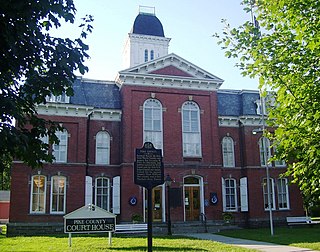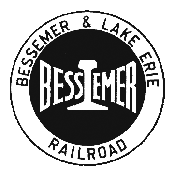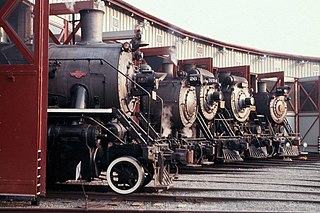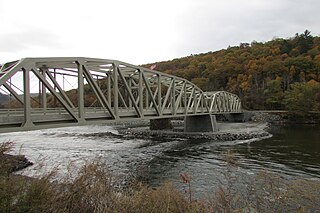
Letchworth State Park is a 14,427-acre (5,838 ha) New York State Park located in Livingston County and Wyoming County in the western part of the State of New York. The park is roughly 17 miles (27 km) long, following the course of the Genesee River as it flows north through a deep gorge and over several large waterfalls. It is located 35 miles (56 km) southwest of Rochester and 60 miles (97 km) southeast of Buffalo, and spans portions of the Livingston County towns of Leicester, Mount Morris and Portage, as well as the Wyoming County towns of Castile and Genesee Falls.

Pike County is a county in the Commonwealth of Pennsylvania. As of the 2020 census, the population was 58,535. Its county seat is Milford. The county is part of the Northeast Pennsylvania region of the state.

Milford is a borough that is located in Pike County, Pennsylvania, United States, and the county seat. Its population was 1,103 at the time of the 2020 census.
Cedar Point is a 364-acre (147 ha) amusement park located on a Lake Erie peninsula in Sandusky, Ohio, United States, owned and operated by Six Flags. It opened in 1870 and is considered the second-oldest operating amusement park in the US behind Lake Compounce. Prior to the merger with Six Flags in 2024, Cedar Point served as the "flagship park" of the Cedar Fair amusement park chain and hosted the corporate headquarters. Known as "America's Roller Coast", the park features 17 roller coasters, which ranks third among amusement parks in North America behind sister parks Canada's Wonderland (18) and Six Flags Magic Mountain (20).

The Bessemer and Lake Erie Railroad was a class II railroad that operates in northwestern Pennsylvania and northeastern Ohio.
A gravity railroad or gravity railway is a railroad on a slope that allows cars carrying minerals or passengers to coast down the slope by the force of gravity alone. The speed of the cars is controlled by a braking mechanism on one or more cars on the train. The cars are then hauled back up the slope using animal power, a locomotive or a stationary engine and a cable, a chain or one or more wide, flat iron bands. A much later example in California used 4 ft 8+1⁄2 instandard gauge steam engines to pull gravity cars back to the summit of Mt. Tamalpais.

The New York and New England Railroad (NY&NE) was a railroad connecting southern New York State with Hartford, Connecticut; Providence, Rhode Island; and Boston, Massachusetts. It operated under that name from 1873 to 1893. Prior to 1873 it was known as the Boston, Hartford and Erie Railroad, which had been formed from several smaller railroads that dated back to 1846. After a bankruptcy in 1893, the NY&NE was reorganized and briefly operated as the New England Railroad before being leased to the competing New York, New Haven and Hartford Railroad in 1898.

Steamtown National Historic Site (NHS) is a railroad museum and heritage railroad located on 62.48 acres (25.3 ha) in downtown Scranton, Pennsylvania, at the site of the former Scranton yards of the Delaware, Lackawanna and Western Railroad (DL&W). The museum is built around a working turntable and a roundhouse that are largely replications of the original DL&W facilities; the roundhouse, for example, was reconstructed from remnants of a 1932 structure. The site also features several original outbuildings dated between 1899 and 1902. All the buildings on the site are listed with the National Register of Historic Places as part of the Delaware, Lackawanna and Western Railroad Yard-Dickson Manufacturing Co. Site.

Nickel Plate Road 765 is a S-2 class 2-8-4 "Berkshire" type steam locomotive built by the Lima Locomotive Works for the New York, Chicago & St. Louis Railroad, commonly referred to as the "Nickel Plate Road". In 1963, No. 765, renumbered as 767, was donated to the city of Fort Wayne, Indiana, where it sat on display at the Lawton Park, while the real No. 767 was scrapped at Chicago in 1964.

Midway State Park, located in Maple Springs, New York, was established in 1898 by the Jamestown & Lake Erie Railway as a picnic ground. Today, it is recognized as the fifteenth-oldest continually operating amusement park in the United States, and the fifth-oldest remaining trolley park of the thirteen still operating in the United States.

The Reading Blue Mountain and Northern Railroad, sometimes shortened to Reading and Northern Railroad, is a regional railroad in eastern Pennsylvania. With a headquarters in Port Clinton, the RBMN provides freight service on over 400 miles (640 km) of track. Its mainline consists of the Reading Division between Reading and Packerton and the Lehigh Division between Lehighton and Dupont. This mainline gives the RBMN a direct route from Reading to Scranton, the first such route to exist under the control of a single railroad. Founded in 1983 to take over from Conrail on the ex-Pennsylvania Railroad Schuylkill Branch between Reading and Hamburg, the railroad quickly grew over the next several decades to become the largest privately-owned Class II railroad in the United States. Its main freight cargo is anthracite coal, but also sees significant shipments in frac sand, forest products, petrochemicals and minerals, food and agricultural products, metals, and consumer products.

Cascade is an unincorporated community and U.S. Post Office in El Paso County, Colorado, United States. The ZIP Code of the Cascade Post Office is 80809.

The Kinzua Bridge or the Kinzua Viaduct was a railroad trestle that spanned Kinzua Creek in McKean County in the U.S. state of Pennsylvania. The bridge was 301 feet (92 m) tall and 2,052 feet (625 m) long. Most of its structure collapsed during a tornado in July 2003.

Grey Towers National Historic Site, also known as Gifford Pinchot House or The Pinchot Institute, is located just off US 6 west of Milford, Pennsylvania, in Milford Township. It is the ancestral summer home of Gifford Pinchot, first chief of the newly developed United States Forest Service (USFS) and twice elected governor of Pennsylvania.

The Pond Eddy Bridge is a truss bridge spanning the Delaware River between the hamlet of Pond Eddy in Lumberland, New York and the settlement informally called Pond Eddy in Shohola Township, Pennsylvania; it is the Pennsylvania community's only road connection. It is accessible from NY 97 in Lumberland on the New York side and two dead-end local roads, Flagstone Road and Rosa Road on the Pennsylvania side. The current bridge was built in 2018, replacing one from 1903.

Ravine Flyer II is a hybrid wooden roller coaster located at Waldameer & Water World in Erie, Pennsylvania. It was ranked as the Best New Ride of 2008 by the Amusement Today magazine. Ravine Flyer II was built on the site of the park's old Ravine Flyer roller coaster, which was dismantled in 1938 after a man died on it. Initial concepts for the replacement ride were developed by Custom Coasters International in the early 1990s, further developed by Dennis McNulty several years later, then finalized and constructed by The Gravity Group, with Jeff Mason overseeing construction.

Cuyahoga Valley Scenic Railroad is a Class III railroad operating diesel-electric and steam-powered excursion trains through Peninsula, Ohio, in the Cuyahoga Valley, primarily through the scenic Cuyahoga Valley National Park.

The Barryville–Shohola Bridge is the fifth generation of bridges constructed over the Delaware River at the communities of Shohola Township, Pennsylvania and Barryville, New York. The bridge serves both communities, with two major state legislative highways, Pennsylvania Traffic Route 434 and New York State Touring Route 55. The bridge itself is 812 feet (247 m) long and is 23 feet (7.0 m) wide, using four total spans across the river. It is maintained by the NY–PA Joint Interstate Bridge Commission, which is jointly owned by the states of New York and Pennsylvania.

Arlington is a former commuter railroad train station in the Arlington section of Kearny, Hudson County, New Jersey. Located on Garafola Place between the Forest and Elm Street intersections, the station served trains on NJ Transit's Boonton Line as well as the only remaining active station in Kearny until its closure. The station, which contained two low-level side platforms, operated trains between Hoboken Terminal and locations west to Dover and Hackettstown. The next station to the east was Hoboken while the station to the west was Rowe Street in Bloomfield.

Pen Mar Park is a scenic area and county park in the community of Pen Mar in Washington County, Maryland. It is located on Pen Mar High Rock Road adjacent to the Mason–Dixon line.






















